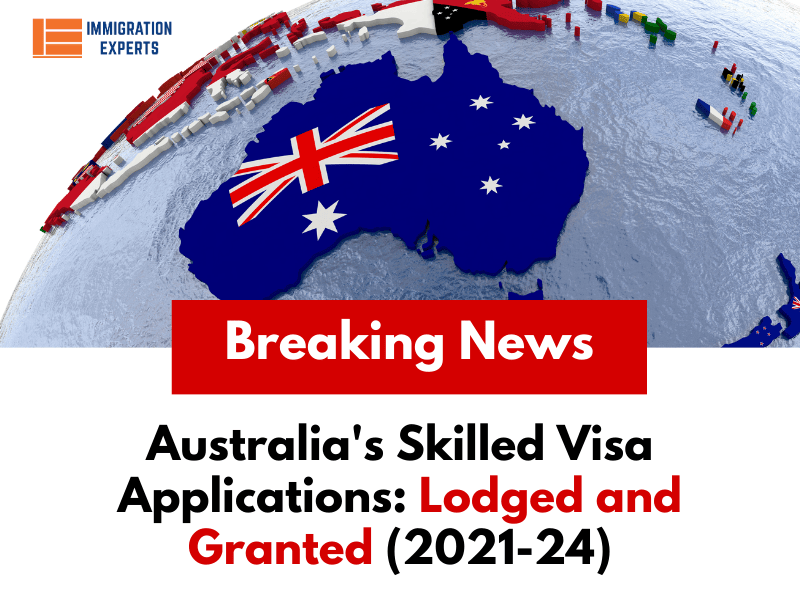051 8439995, 042 35911332

The data on skilled visa applications lodged in Australia from 2021-22 to 2023-24 (up to 31 March 2024) provides a comprehensive view of the trends in skilled migration. These trends reflect changes in policy, economic conditions, and the demand for skilled workers in various regions of the country.
Things You Will Find In This Page
Skilled Visa Applications Lodged: 2021-2024
| Visa Category | 2021-22 | 2022-23 | 2023-24 (to 31/03/2024) |
|---|---|---|---|
| Employer Sponsored | 34,980 | 41,992 | 32,439 |
| Skilled Independent | 7,512 | 49,109 | 9,378 |
| State/Territory Nominated | 25,578 | 61,186 | 16,333 |
| Business Innovation & Investment | 14,156 | 8,384 | 3,255 |
| Global Talent | 8,698 | 7,159 | 4,606 |
| Distinguished Talent | 336 | 400 | 336 |
| Grand Total | 91,260 | 168,230 | 66,347 |
Source: Department of Home Affairs, 2024
Key Insights
- The surge in 2022-23: There was an 84.3% increase in the number of skilled visa applications from 91,260 in 2021-22 to 168,230 in 2022-23. Higher planning levels for the Skilled Independent and State/Territory Nominated categories primarily drove this significant rise. These categories saw increased nomination allocations and invitation rounds by the Department of Home Affairs.
- Decline in 2023-24: As of 31 March 2024, there was a 46.9% decrease in applications compared to the same period in 2022-23. This decline is attributed to reduced State and Territory Nominations and Skilled Independent invitations. The decrease is part of a strategy to manage application pipelines and processing times effectively, considering the existing volume of applications for the 2023-24 planning levels.
- Skilled Visa Categories: The Employer Sponsored and Skilled Independent categories remained significant, although they experienced fluctuations. The State/Territory Nominated category also showed variable trends, reflecting policy adjustments and regional needs.
Regional Visa Applications Lodged: 2021-2024
| Visa Subclass | 2021-22 | 2022-23 | 2023-24 (to 31/03/2024) |
|---|---|---|---|
| 187 Regional Sponsored Migration Scheme | 1,634 | 514 | 92 |
| 191 Permanent Residence (Skilled Regional) | 131 | 1,168 | 7,529 |
| 489 Skilled – Regional (Provisional) | 372 | 333 | 143 |
| 491 Skilled Work Regional (Provisional) | 26,314 | 47,814 | 14,204 |
| 494 Skilled Employer Sponsored Regional | 3,165 | 3,752 | 2,724 |
| 887 Skilled – Regional | 10,886 | 2,076 | 2,116 |
| Grand Total | 42,502 | 55,657 | 26,808 |
Source: Department of Home Affairs, 2024
Key Developments
- Introduction of Subclass 191: The Permanent Residence (Skilled Regional) subclass 191 visa was introduced on 16 November 2022. By 31 March 2024, over 7,500 applications were lodged, reflecting the growing number of eligible applicants meeting regional residency and other requirements.
- Consistent Demand: The 491 Skilled Work Regional (Provisional) visa continued to see strong demand, though there was a decline from 47,814 in 2022-23 to 14,204 in 2023-24. This decline aligns with the overall strategy to manage the volume of applications and processing times.
Regional Visa Applications Finalised: 2021-2024
| Visa Subclass | Outcome | 2021-22 | 2022-23 | 2023-24 (to 31/03/2024) |
|---|---|---|---|---|
| 187 Regional Sponsored Migration Scheme | Granted | 1,797 | 3,275 | 898 |
| Refused/Withdrawn | 240 | 391 | 89 | |
| Total | 2,037 | 3,666 | 987 | |
| 489 Skilled – Regional (Provisional) | Granted | 1,156 | 3,487 | 1,026 |
| Refused/Withdrawn | 112 | 423 | 176 | |
| Total | 1,268 | 3,910 | 1,202 | |
| 491 Skilled Work Regional (Provisional) | Granted | 13,898 | 23,129 | 24,739 |
| Refused/Withdrawn | 912 | 5,061 | 1,006 | |
| Total | 14,810 | 28,190 | 25,745 | |
| 494 Skilled Employer Sponsored Regional | Granted | 1,348 | 3,793 | 3,110 |
| Refused/Withdrawn | 177 | 578 | 411 | |
| Total | 1,525 | 4,371 | 3,521 | |
| 887 Skilled – Regional | Granted | 2,070 | 19,655 | 2,097 |
| Refused/Withdrawn | 118 | 219 | 66 | |
| Total | 2,188 | 19,874 | 2,163 | |
| 191 Permanent Residence (Skilled Regional) | Granted | <50 | <235 | 5,539 |
| Refused/Withdrawn | <5 | <5 | 17 | |
| Total | 47 | 235 | 5,556 | |
| Grand Total | 21,875 | 60,246 | 39,174 |
Source: Department of Home Affairs, 2024
Final Thoughts
The data highlights significant trends in Australia’s skilled and regional visa categories, reflecting shifts in policy and regional demands. The substantial increase in applications in 2022-23 followed by a strategic reduction in 2023-24 underscores the dynamic nature of immigration management aimed at balancing the influx of skilled workers with processing capabilities and regional needs. The introduction of the subclass 191 visa and the consistent demand for the 491 visa illustrate the evolving landscape of regional migration, catering to immediate and long-term economic requirements.
